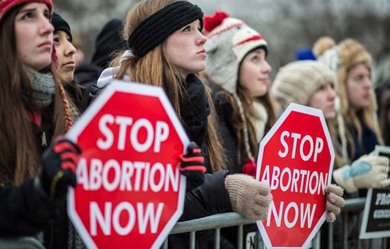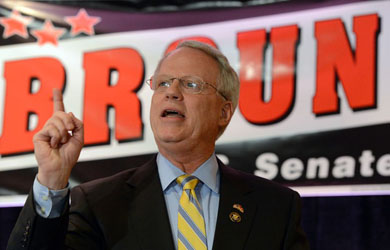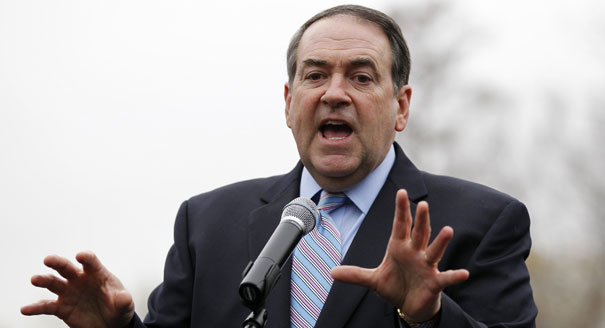This is the third post in a RWW series on the reemergence of the fetal personhood movement and what it means for the future of abortion rights in the U.S.
Part 1: The Personhood Movement: Where It Comes From And What It Means For The Future Of Choice
Part 2: The Personhood Movement: Internal Battles Go Public
Part 4: The Personhood Movement: Regrouping After Defeat
As we have detailed in previous posts in this series, ever since the anti-choice movement rose to prominence in the wake of Roe v. Wade, it has been divided over how to go about repealing Roe and recriminalizing abortion in the U.S.
Groups like Americans United for Life (AUL) and the National Right to Life Committee (NRLC) have achieved great success in pushing states to adopt incremental measures targeting abortion providers in the name of protecting women’s health and in advocating for national policies — such as the 2003 “partial-birth” abortion ban and the 20-week abortion ban currently being considered by Congress — that attempt to undermine the legal reasoning in Roe by targeting a small segment of abortion procedures.
But the anti-choice personhood movement believes that the incremental strategy is doing too little to end legal abortion. They believe they have a better plan.
The personhood movement argues that small, incremental legal victories cutting off access to abortion will never achieve the ultimate goal of completely criminalizing the procedure — in part because those measures fail to make a moral argument on behalf of the humanity of the fertilized egg and fetus.
At the founding convention of the Personhood Alliance late last year, the chief of staff to Alabama Supreme Court Chief Justice Roy Moore, notorious for his legal fight over a Ten Commandment monument he placed in the courthouse rotunda, discussed an alternate legal strategy to end abortion rights. As Nina Martin has outlined in The New Republic, Moore’s protégé and colleague Justice Tom Parker has been carefully laying out a legal framework to overturn Roe, not by constitutional amendment, but by the legal redefinition of what it means to be a person protected by the law.
Parker, with Moore’s backing, has been building a body of jurisprudence that offers a blueprint for a personhood victory in the courts. In doing so, he’s drawn the attention and praise of anti-choice activists; Liberty Counsel, a right-wing legal group, has called him a “modern-day Wilberforce.”
Since efforts to overturn Roe by passing a Human Life Amendment or a legislative alternative faltered in Congress in the 1970s and 1980s, personhood advocates have focused on the states, passing legislation giving limited rights to fetuses as separate entities from pregnant women. Since 1986, 38 states have passed “fetal homicide” laws identifying fetuses at some or all stages of development as separate victims of crime and in 2004 Congress passed a similar law covering federal crimes. Similarly, in 18 states substance abuse during pregnancy is legally considered child abuse. In Alabama last year, Republicans passed a law allowing judges to appoint lawyers for fetuses. As Elizabeth Nash, senior state issues associate at the Guttmacher Institute, put it in an interview, “all of that is about trying to build up a legal case that personhood starts at fertilization.”
Personhood USA’s 2014 attempt to insert personhood language into Colorado law drew on this legal history, specifically limiting its new definition of personhood to the Colorado criminal code and Colorado Wrongful Death Act. But the proposal was nonetheless widely recognized as an attempt to ban abortion, or at least to set up a legal battle challenging Roe. In fact, Colorado had already passed laws imposing extra penalties for crimes against pregnant women, the purported purpose of the personhood amendment. “They are changing the tone, they are changing the language, they are changing the messaging to try to win,” Nash said.
Parker has chronicled laws treating fetuses as full-fledged humans in certain cases to argue that “[t]oday, the only major area in which unborn children are denied legal protection is abortion, and that denial is only because of Roe.” He has urged the Supreme Court to address the issue at the next chance it gets.
Parker and Moore’s strategy relies on what the personhood movement’s proponents believe is a loophole in Roe v. Wade that would allow anti-abortion advocates to effectively undo the decision without a constitutional amendment or a Supreme Court friendlier to their cause. In Roe, the Justices rejected the idea of fetal personhood. Justice Blackmun wrote in his majority opinion that “no case could be cited that holds that a fetus is a person within the meaning of the Fourteenth Amendment,” noting, “If this suggestion of personhood is established, the appellant’s case, of course, collapses…for the fetus’ right to life would then be guaranteed specifically by the Amendment.”
A federal bill that currently has 132 cosponsors in the House and 21 in the Senate takes aim at this supposed loophole in Roe, simply declaring that “the right to life guaranteed by the Constitution is vested in each human being,” which includes “each member of the species homo sapiens at all stages of life, including the moment of fertilization, cloning, or other moment at which an individual member of the human species comes into being.”
Sen. Rand Paul of Kentucky, the chief sponsor of the Senate bill, signed a fundraising email for the pro-personhood National Pro-Life Alliance in November, arguing that his was the strategy that would work:
The Supreme Court itself admitted — if Congress declares unborn children ‘persons’ under the law, the constitutional case for abortion-on-demand ‘collapses.’
Alabama’s Supreme Court is the most prominent court to give a serious hearing to the personhood strategy, long considered by even some in the anti-choice movement to be a crackpot theory and a potential political and legal disaster. As recently as 2009, Clarke Forsythe, senior counsel at Americans United for Life, wrote in the National Review that the so-called “personhood loophole” was an “urban legend” and those pursuing it were “heading toward a brick wall.” Forsythe argued that in 1992 Casey decision, the Supreme Court had shifted the abortion debate from the personhood of fetuses to the rights of women, and that that was therefore the ground that the anti-choice movement should be playing on. “The real challenge for pro-lifers in 2009 is to effectively address the assumption that abortion is good for women,” he wrote, presaging AUL’s revamped woman-focused messaging.
Even more alarming to the personhood strategy’s detractors in the anti-choice movement is the possibility that a personhood challenge to Roe could create the opportunity for a Supreme Court ruling that would actually strengthen constitutional protections for abortion rights. Justice Ruth Bader Ginsburg, for instance, has said that she believes abortion rights should be secured under the equal protection clause of the 14th Amendment, making the issue more clearly about the rights of women. In 2010, Austin Ruse of the Catholic Family & Human Rights Institute (C-FAM) wrote, “If a personhood amendment comes before this court, a new and terrifying decision may put the pro-life movement back a quarter century or more.”
In 2007, as the anti-choice movement’s schism over a ban on so-called “partial-birth” abortion was gaining national attention, Georgia Right to Life, which was at the the state affiliate of NRLC, worked with legislators to introduce a state constitutional amendment defining a “person” under state law as “including unborn children at every state of their biological development, including fertilization.”
Although the Georgia amendment was based on language originally drafted as a federal constitutional amendment by NRLC, NRLC’s chief counsel James Bopp, Jr. tried to shut it down. In a lengthy and frank memo to his fellow anti-choice activists, Bopp contended that such an amendment would be immediately struck down in federal courts and, if it made it to the Supreme Court, could give the court’s majority the opportunity to rewrite Roe in the way favored by Ginsburg. The state-level personhood strategy, he cautioned, was “presently doomed to expansive failure.”
Instead, Bopp said, the anti-choice movement should continue its incremental strategy, which was succeeding in curtailing access to abortion while keeping the issue in the public eye. He wrote that the “partial-birth” abortion law had been a successful example of this strategy because it “forced the pro-abortion camp to publicly defend a particularly visible and gruesome practice.” Acknowledging that “most pro-lifers” believe that abortion should only be available to save the life of a pregnant woman, he warned that absolutist, no-exceptions approaches like personhood were both legally unwise and poor public relations:
By contrast, the pro-life movement must at present avoid fighting on the more difficult terrain of its own position, namely arguing that abortion should not be available in cases of rape, incest, fetal deformity, and harm to the mother. While restricting abortion in these situations is morally defensible, public opinion polls show that popular support for the pro-life side drops off dramatically when these “hard” cases are the topic. And while most pro-lifers believe that a consistent pro-life position requires permitting abortion in only the rare circumstances where it is necessary to save the life of the mother, some pro-lifers believe that there should not even be an exception to preserve the life of the mother. Other pro-lifers advocate exceptions for rape or incest. This is an important debate to have, and we should be ready to convince the public of the need for few, if any, exceptions to laws prohibiting abortion when such laws can be upheld. However, since that is currently not the case, such a debate is premature and would undermine public support for the pro-life position.
Responding to Bopp’s memo, the conservative Thomas More Law Center, which drafted the Georgia amendment, argued that the incremental strategy had taken too long and done too little and that “after 34 years of abortion on demand through all nine months of pregnancy, it is time to rethink pro-life strategy.”
“[T]he central holding of Roe v. Wade remains the primary obstacle to any meaningful pro-life initiative that seeks to end abortion,” wrote Thomas More attorney Robert J. Muise. “To remove this obstacle, a case must be presented to the United States Supreme Court that challenges the central premise of Roe — that the unborn is not a person within the meaning of the law.”
If personhood laws were to succeed in the courts, the legal implications would be immense and unpredictable.
The ambiguous wording of personhood measures has led to concerns that they could be interpreted to outlaw oral contraception, IUDs and in-vitro fertilization. But birth control is not the only issue. As the National Advocates for Pregnant Women’s Lynn Paltrow and Fordham sociologist Jeanne Flavin have documented, laws granting legal rights to fetuses outside the context of abortion have led to hundreds of cases of pregnant women being arrested or otherwise apprehended after suffering miscarriages or for alleged drug and alcohol use deemed to be harmful to the fetus.
In countries that completely criminalize abortion — the goal of the “pro-life” movement in the U.S. — pregnant woman can find themselves in terrifying situations: recently in El Salvador, a woman was sentenced to 30 years in prison for murder after suffering a miscarriage.
As Paltrow told Newsweek in 2012, “There’s no way to give embryos constitutional personhood without subtracting women from the community of constitutional persons.”
By redefining what it means to be a person under the law, personhood measures could also have a broad legal impact on issues unrelated to reproductive rights, threatening to upend everything from inheritance law to census results. In 2014, the Colorado Bar Association opposed the state’s personhood ballot measure, warning that the vaguely worded measure would have “potentially serious, unintended and unknown consequences for Colorado lawyers…From areas of Family Law to Probate Law to Real Estate Law, as well as the explicit effect on Criminal Law and Wrongful Death statutes, this Amendment could create uncertainty and endless litigation.”
Daniel Becker, the former leader of Georgia Right to Life and founder of the Personhood Alliance, also sees the personhood issue as extending beyond abortion rights, but in a different direction. The final chapter of Becker’s 2011 manifesto, “Personhood,” is written in the form of a science fiction story set in a “post-human future” in which computers have gained consciousness, procreation has been moved to laboratories, and a “specialized sub-class of human-animal hybrids” has been developed to perform menial labor. The anti-abortion rights movement, he argues, will cease to be relevant in coming battles over biotechnology if it remains “at its heart, anti-abortion as opposed to pro-sanctity of human life.” He argues that only by embracing full “personhood” rights for zygotes and fetuses will the movement remain viable in the future.
The personhood movement, while it has hope in the legal system, also recognizes that it won’t get far without winning hearts and minds. In the final post in this series, we’ll look at the movement’s efforts to reorganize in the wake of electoral defeats.






